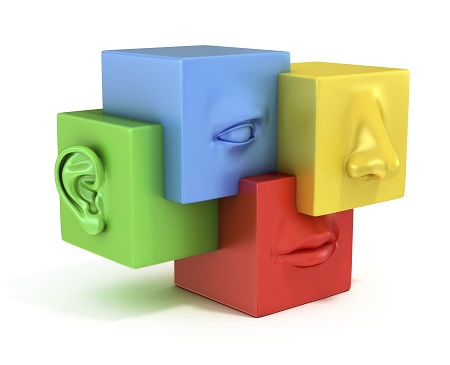Want Great KPIs? You Have to Get Sensory…
by Stacey BarrThe building blocks of KPIs and performance measures is detectable evidence. And evidence is detectable when it is sensory.

We can only measure what we can observe or detect. If we have no way of seeing or hearing or touching something, how could we ever know if it was happening or changing?
This is why if our goals are written in weasel words, we have huge struggles to measure them. Weasel words don’t describe observable things. We cannot observe ‘effectiveness’, so we don’t know what to count to quantify and measure it. But we can see errors in workmanship, and we can count them. We can hear customers asking for corrections, and we can count them.
But this problem goes away when we describe our goals with sensory language.
Sensory language is one of the most important requirements for great KPIs.
Imagine that you’re holding a fresh, bright yellow lemon in your left hand. It feels waxy – maybe even squeaky – and dimply under your fingertips. It’s heavy for its size, which makes you think it’s very juicy. With your index fingernail, you scratch the skin and watch a fine mist of lemon oil spray into the air. You lift the lemon to your nose to smell the sharp citrusy fragrance…
Now take a bite.
Did anything happen? When I first heard this, and obligingly followed the instructions, my face screwed up in response to the expectation of the sour lemon taste. Why would this happen if we don’t have an actual lemon in our hands?
That’s the power of sensory-specific language. It makes things real.
Sensory-specific language is based on words that describe what our senses can detect: what we see, hear, touch, feel, taste or smell. Sensory nouns, adjectives, and adverbs are all useful in describing our goals measurably. Like these:
angular, abrasive, blurred, buzzing, burnt, cluttered, crushed, dark, deep, doughy, enormous, echo, foggy, fragile, green, high, hiss, humid, irregular, itchy, juicy, knotted, littered, loud, muscular, melted, narrow, noisy, opaque, odourless, pale, quiet, quick, speechless, spotty, swollen, tubular, tight, vivid, wavy, yellow
In contrast, weasel words are ambiguous and vague and have many different meanings to different people in different contexts. You’ll be very familiar with these:
accessibility, accountability, balanced, benefits, capacity, core, deployable, diversity, effective, empowered, flexible, fundamental, governance, ground-breaking, harness, harvested, inclusive, innovative, key, lean, leveraged, mandated, needs, opportunities, outcomes, pathways, progressive, quality, recognition, re-energise, significant, special, targeted, transparent, underpinning, utilised, value-added, vibrant, wellbeing, winning
Write your goals with sensory-specific language
The better we can describe our goals in sensory-specific language, the more obvious it becomes what we should measure to know if the goal is being achieved.
This goal is the first (weaselly) version of a local government goal:
“Enhance our protection of the natural landscape.”
A goal written like this is really tough to measure. What exactly is protection? Protection from what? And what natural landscape are we talking about? Protection of exactly which features or aspects of this natural landscape?
We have a snowflake’s chance in a bushfire of quickly finding meaningful measures of goals written like this. We need to answer those questions. We need to think seriously about what we’d expect to see or touch or smell or observe, if the natural landscape were protected.
In other words, we need to rewrite the goal using sensory-specific language. And the local government did, and arrived at this new sensory version:
“The fragile soils of ridges and escarpments, and valuable farming and urban land, are protected from unnatural erosion and loss of topsoil.”
Straight away we can visualise what this goal means. We see in our minds’ eyes the rolling hills and rocky outcrops, the earthy patchwork of crops, vast green pastures dotted with cows or sheep grazing. We see black or red topsoil in some places, and grey and cracked and dry ruts in the earth in other places.
And consequently, we can see very strong potential to quantify this goal:
- The area of land that shows erosion.
- The area of land that has lost its topsoil.
- Estimated volume of soil that has moved from where it should be.
3 ways to increase your sensory language skills…
Using sensory language takes practice. We don’t need to master it, however, before it becomes profoundly useful in our KPI work. To get some practice, here are three easy things to try.
Firstly, read poetry. One of my favourites, for its quirky and repetitive rhythm and dark imagery, is “The Raven” by Edgar Allan Poe.
“And the silken, sad, uncertain rustling of each purple curtain
Thrilled me—filled me with fantastic terrors never felt before;
So that now, to still the beating of my heart, I stood repeating
“‘Tis some visitor entreating entrance at my chamber door—
Some late visitor entreating entrance at my chamber door;—
This it is and nothing more.””
– excerpt from “The Raven” by Edgar Allan Poe
Secondly, keep your own list of sensory words. Particularly sensory nouns, adjectives and adverbs that relate to the context of your organisation’s work. This helps develop the muscle of thinking in sensory language, as well as building a resource to help when you need to measure a goal.
Thirdly and finally, before you start measuring any goal, keep asking questions like “what would we see?” and “what might we hear?” and “what could we reach out and touch?”.
By the way, if you find yourself thinking that your goals are essentially intangible, and this doesn’t apply, then ask yourself this: “If I cannot observe or detect this goal happening or changing, what’s the point of having it as a goal?”
Connect with Stacey
Haven’t found what you’re looking for? Want more information? Fill out the form below and I’ll get in touch with you as soon as possible.
167 Eagle Street,
Brisbane Qld 4000,
Australia
ACN: 129953635
Director: Stacey Barr




